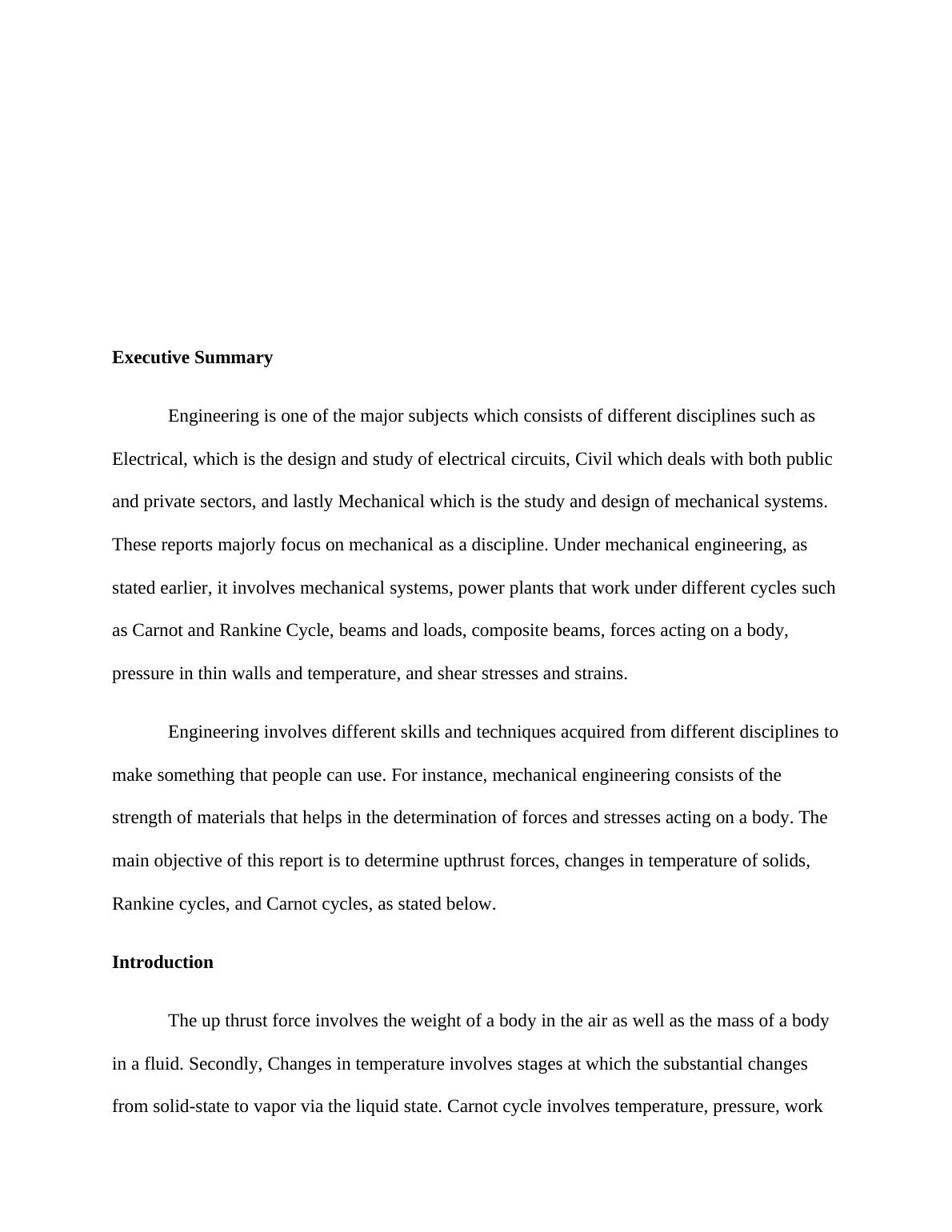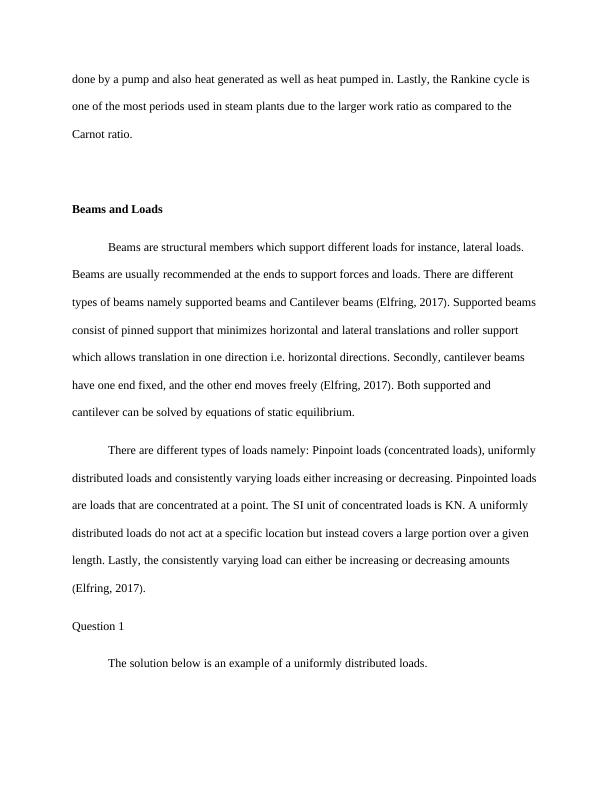Friction of Metal-Matrix Self- Lubricating
Added on 2022-08-24
18 Pages1419 Words18 Views
By (Name)
Name of the Course
Name of Institution
Location of Institution
Name of the Course
Name of Institution
Location of Institution

Executive Summary
Engineering is one of the major subjects which consists of different disciplines such as
Electrical, which is the design and study of electrical circuits, Civil which deals with both public
and private sectors, and lastly Mechanical which is the study and design of mechanical systems.
These reports majorly focus on mechanical as a discipline. Under mechanical engineering, as
stated earlier, it involves mechanical systems, power plants that work under different cycles such
as Carnot and Rankine Cycle, beams and loads, composite beams, forces acting on a body,
pressure in thin walls and temperature, and shear stresses and strains.
Engineering involves different skills and techniques acquired from different disciplines to
make something that people can use. For instance, mechanical engineering consists of the
strength of materials that helps in the determination of forces and stresses acting on a body. The
main objective of this report is to determine upthrust forces, changes in temperature of solids,
Rankine cycles, and Carnot cycles, as stated below.
Introduction
The up thrust force involves the weight of a body in the air as well as the mass of a body
in a fluid. Secondly, Changes in temperature involves stages at which the substantial changes
from solid-state to vapor via the liquid state. Carnot cycle involves temperature, pressure, work
Engineering is one of the major subjects which consists of different disciplines such as
Electrical, which is the design and study of electrical circuits, Civil which deals with both public
and private sectors, and lastly Mechanical which is the study and design of mechanical systems.
These reports majorly focus on mechanical as a discipline. Under mechanical engineering, as
stated earlier, it involves mechanical systems, power plants that work under different cycles such
as Carnot and Rankine Cycle, beams and loads, composite beams, forces acting on a body,
pressure in thin walls and temperature, and shear stresses and strains.
Engineering involves different skills and techniques acquired from different disciplines to
make something that people can use. For instance, mechanical engineering consists of the
strength of materials that helps in the determination of forces and stresses acting on a body. The
main objective of this report is to determine upthrust forces, changes in temperature of solids,
Rankine cycles, and Carnot cycles, as stated below.
Introduction
The up thrust force involves the weight of a body in the air as well as the mass of a body
in a fluid. Secondly, Changes in temperature involves stages at which the substantial changes
from solid-state to vapor via the liquid state. Carnot cycle involves temperature, pressure, work

done by a pump and also heat generated as well as heat pumped in. Lastly, the Rankine cycle is
one of the most periods used in steam plants due to the larger work ratio as compared to the
Carnot ratio.
Beams and Loads
Beams are structural members which support different loads for instance, lateral loads.
Beams are usually recommended at the ends to support forces and loads. There are different
types of beams namely supported beams and Cantilever beams (Elfring, 2017). Supported beams
consist of pinned support that minimizes horizontal and lateral translations and roller support
which allows translation in one direction i.e. horizontal directions. Secondly, cantilever beams
have one end fixed, and the other end moves freely (Elfring, 2017). Both supported and
cantilever can be solved by equations of static equilibrium.
There are different types of loads namely: Pinpoint loads (concentrated loads), uniformly
distributed loads and consistently varying loads either increasing or decreasing. Pinpointed loads
are loads that are concentrated at a point. The SI unit of concentrated loads is KN. A uniformly
distributed loads do not act at a specific location but instead covers a large portion over a given
length. Lastly, the consistently varying load can either be increasing or decreasing amounts
(Elfring, 2017).
Question 1
The solution below is an example of a uniformly distributed loads.
one of the most periods used in steam plants due to the larger work ratio as compared to the
Carnot ratio.
Beams and Loads
Beams are structural members which support different loads for instance, lateral loads.
Beams are usually recommended at the ends to support forces and loads. There are different
types of beams namely supported beams and Cantilever beams (Elfring, 2017). Supported beams
consist of pinned support that minimizes horizontal and lateral translations and roller support
which allows translation in one direction i.e. horizontal directions. Secondly, cantilever beams
have one end fixed, and the other end moves freely (Elfring, 2017). Both supported and
cantilever can be solved by equations of static equilibrium.
There are different types of loads namely: Pinpoint loads (concentrated loads), uniformly
distributed loads and consistently varying loads either increasing or decreasing. Pinpointed loads
are loads that are concentrated at a point. The SI unit of concentrated loads is KN. A uniformly
distributed loads do not act at a specific location but instead covers a large portion over a given
length. Lastly, the consistently varying load can either be increasing or decreasing amounts
(Elfring, 2017).
Question 1
The solution below is an example of a uniformly distributed loads.

Clockwise moments about R1
1.5 ×800+ 4 ×300 ( 4
2 +4 )
Anticlockwise moments about R1
R 2× 8
Therefore R2 is calculated as follows
R 2× 8=8400
R 2=1050 kN
To calculate R1
Sum of upward forces=sum of downward forces
R 1+ R 2=800+300 × 4 R 1+1050=2000 R 1=950
Upthrust and Tensional forces.
1.5 ×800+ 4 ×300 ( 4
2 +4 )
Anticlockwise moments about R1
R 2× 8
Therefore R2 is calculated as follows
R 2× 8=8400
R 2=1050 kN
To calculate R1
Sum of upward forces=sum of downward forces
R 1+ R 2=800+300 × 4 R 1+1050=2000 R 1=950
Upthrust and Tensional forces.

End of preview
Want to access all the pages? Upload your documents or become a member.
